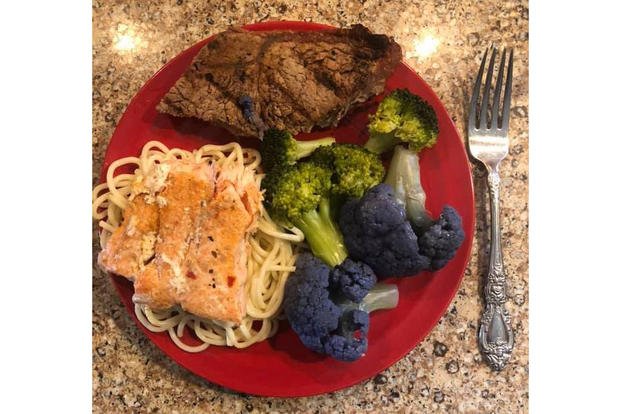For most Americans, portion control is the main killer to the stomach, waistline and hips. It does not take a dietitian or nutritionist to know that eating excess sugar and empty calories are not good for your overall health.
There are many recipes and a wide variety of food in a clean and healthy diet with a balance of fruits and vegetables, lean protein sources and nutritious grains and fats. Finding the ones that best fit your palate is the bigger challenge.
Even if you eat healthy, you still can overeat and have too many calories in the eating surplus column versus the workout deficit column. How do you work around the truth that you can't outwork your diet, even if it is a nutritious one? Here are some tips.
Plan your eats and eat your plan. There is an old saying in SEAL training during training for combat diving missions: "Plan your dive and dive your plan." Same goes for eating.
You need to have the initiative to plan your meals and then the discipline to stick to that plan without extra grazing, adding second helpings or snacking. That is the hard part.
Actually, working out for an hour a day is the easy part of the calories in/calories out equation. The hard part is not overeating the remaining 23 hours of the day.
Eat dinner on a salad plate; eat salads on a dinner plate. Seriously, Americans eat way too much, and we have a habit of "finishing our plates."
Solution? Get smaller plates. No need to buy anything new. Just put less food on a smaller plate and save leftovers for another meal. If eating in a restaurant, typically half of that plate can go home with you and be eaten as another meal. Portions are way too big in America, and so are the corresponding weight-carrying areas on our bodies (hips, butt, stomach).
If you like salads, make them big with green leafy lettuce, romaine, kale or spinach with some other fruit, vegetable and nut options on top. I personally like tomatoes, strawberries, mushrooms, red onions, walnuts and maybe a piece of fish or chicken on top. Don't drown your salad with dressings; go light with oils or vinaigrettes. If you get some tasty toppings, you will find an Italian or house dressing is enough. If you want to avoid those extra calories, go with squeezed lemon to spice up the salad and toppings.
Record your daily habits. It is easy to sneak in a few extra hundred calories and not even know it. Many do this with sweetened drinks, an extra spoonful of peanut butter or by snacking on bite-sized candies and cookies that are too easily available. The best thing to do is to keep those things out of sight.
Keep track of every food and drink that goes into your body for a few days, and you will see the leaks in the diet. I realized I had a 400 calorie-a-day peanut butter habit that was preventing me from losing weight. I was maintaining weight with a good balance of activity, but once I stopped the peanut butter, I dropped 1-2 pounds a week with no other changes. Follow this plan, and you will know what specifically to change. It may be something really simple.
Drink more water. Drinking water throughout the day and especially before meals will decrease the amount of food you can stuff into your stomach. Just by warding off dehydration, you may avoid the food cravings that are associated with being thirsty. Depending on your physical activity and size, you will be in the zone if you can drink a half-gallon to a gallon of water per day. Or try 50% of your body weight in pounds equals the amount of water you should drink in ounces per day. Add up to 25% more if you are sweating during physical activity.
Eat slower and work for it. If you can chew your food longer and take pauses between bites, you can lengthen the time of eating. That will allow for your "full trigger" to respond. It typically takes about 20 minutes to feel full. Many of us overeat in 20 minutes, then feel stuffed.
Try to avoid the "overfed" state and just get to the "not hungry anymore" state. Also consider working for your foods and snacks. Food that you need to peel, crack open and work for are great options. Crab, lobster, shrimp, nuts, beans, oranges and pistachios are good examples.
Having smaller portions on your plate is a great way to start this process. After you clean your smaller plate, drink something and wait for a few minutes, and you may find that you are no longer hungry even though you thought you were 5-10 minutes earlier.
Breaking habits is never easy, but with some of these easy-to-implement life hacks, you may find that the road to eating less is less bumpy. Combine eating smaller meals of good nutritious food along with increasing your activity level, and you will be well on your way to creating that daily caloric deficit needed to lose more weight steadily.

Stew Smith is a former Navy SEAL and fitness author certified as a Strength and Conditioning Specialist (CSCS) with the National Strength and Conditioning Association. Visit his Fitness eBook store if you’re looking to start a workout program to create a healthy lifestyle. Send your fitness questions to stew@stewsmith.com.
Want to Learn More About Military Life?
Whether you're thinking of joining the military, looking for fitness and basic training tips, or keeping up with military life and benefits, Military.com has you covered. Subscribe to Military.com to have military news, updates and resources delivered directly to your inbox.















